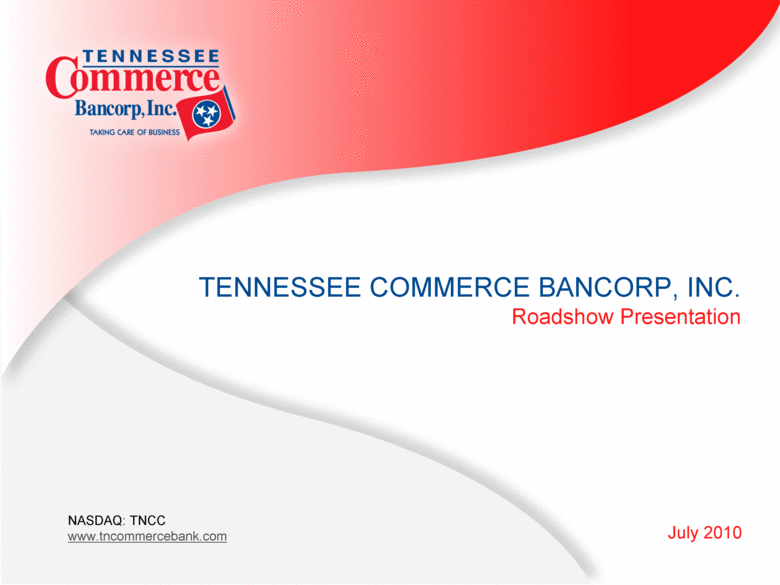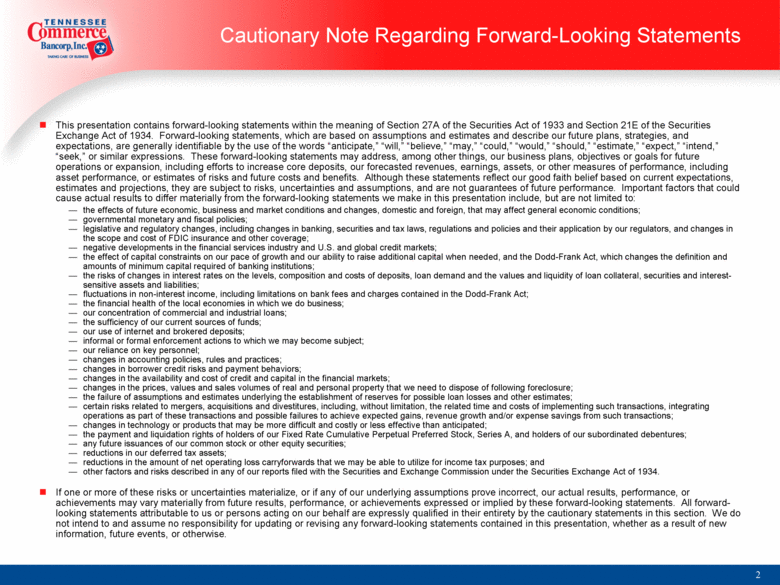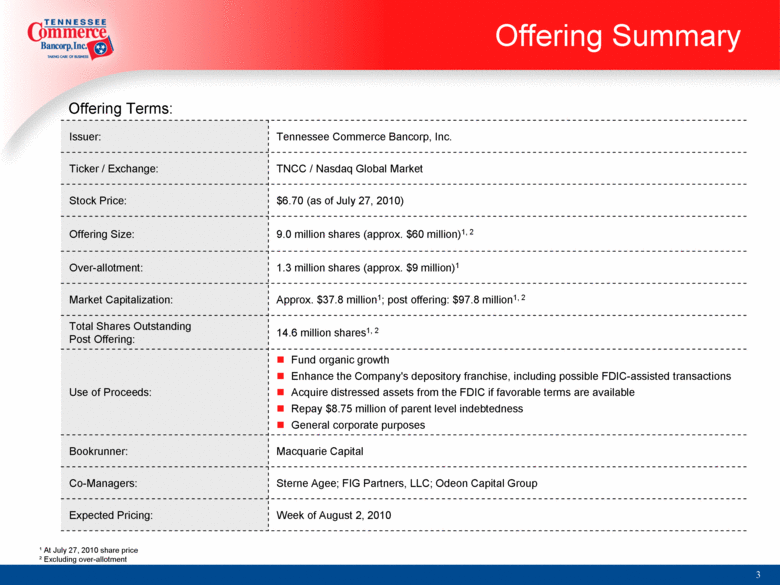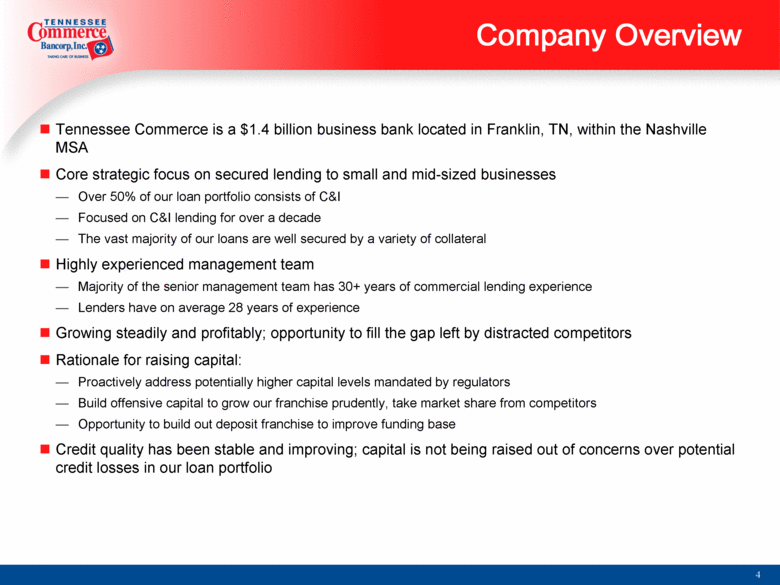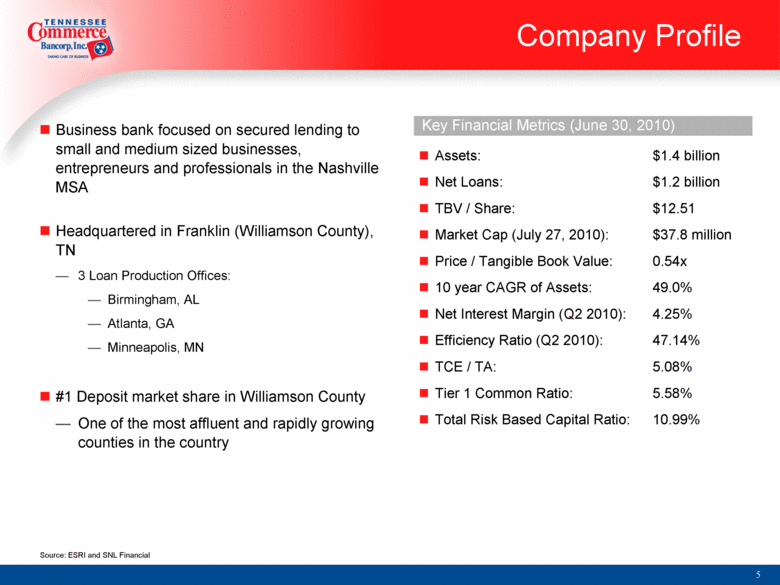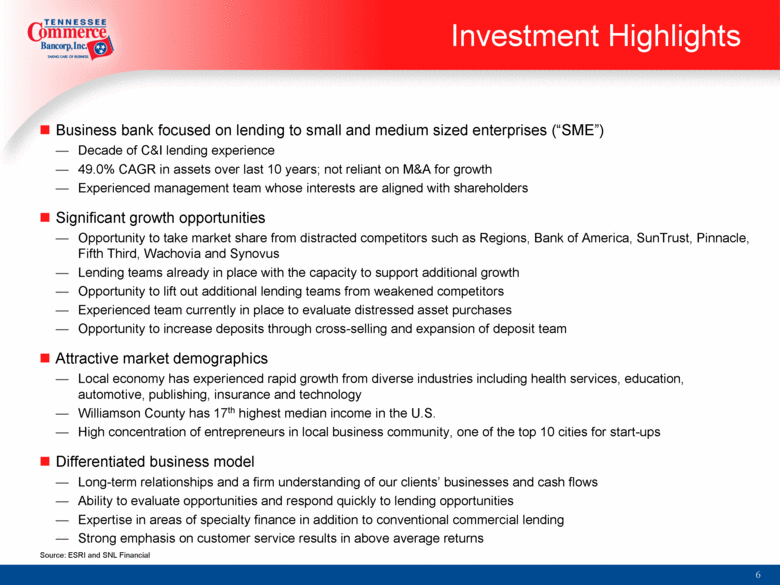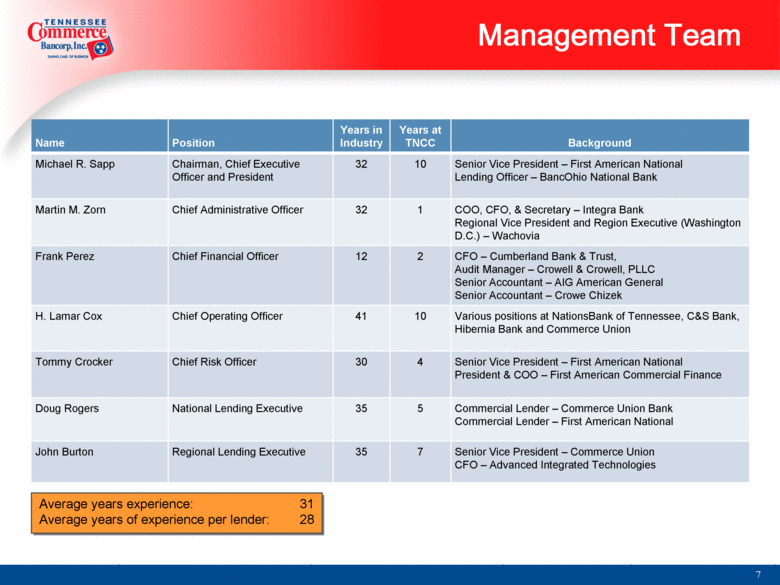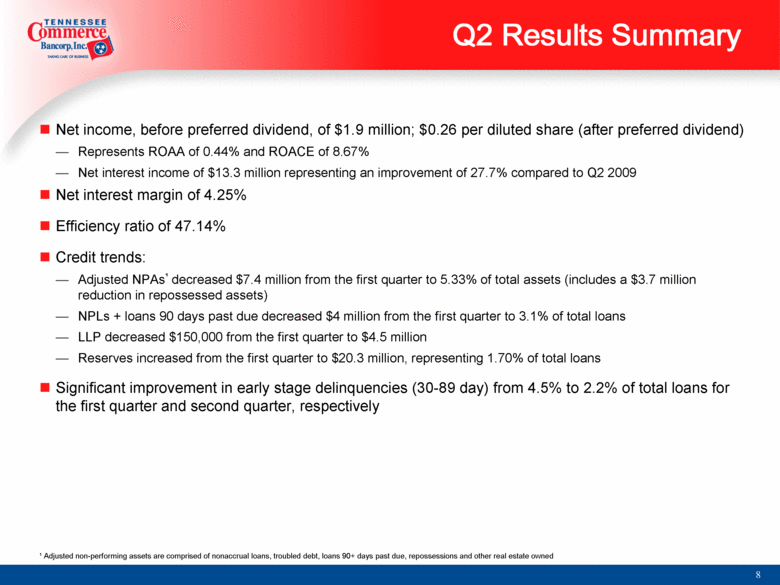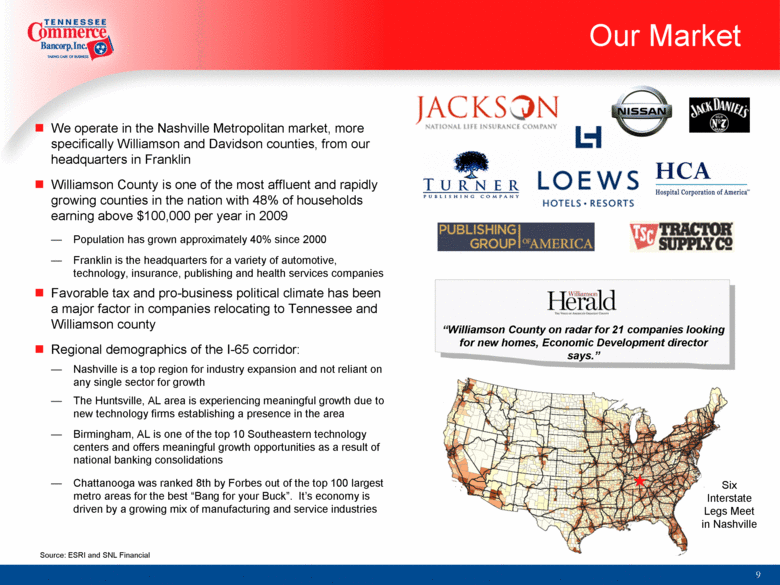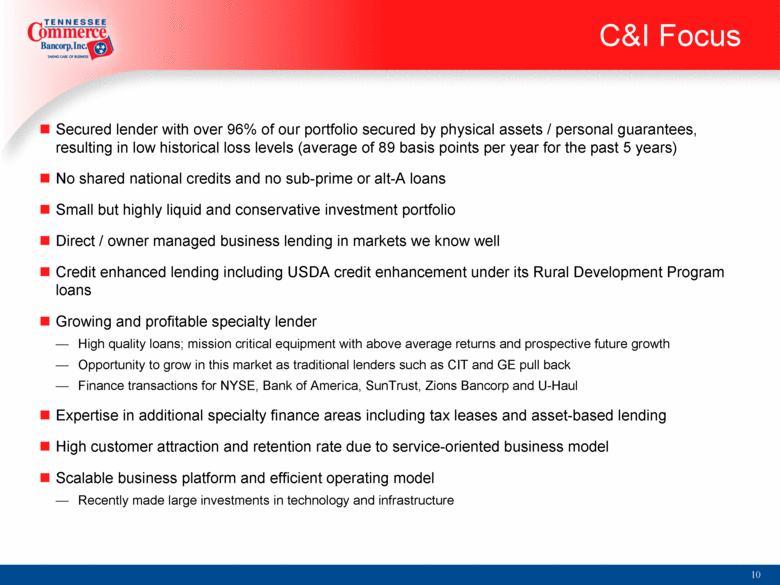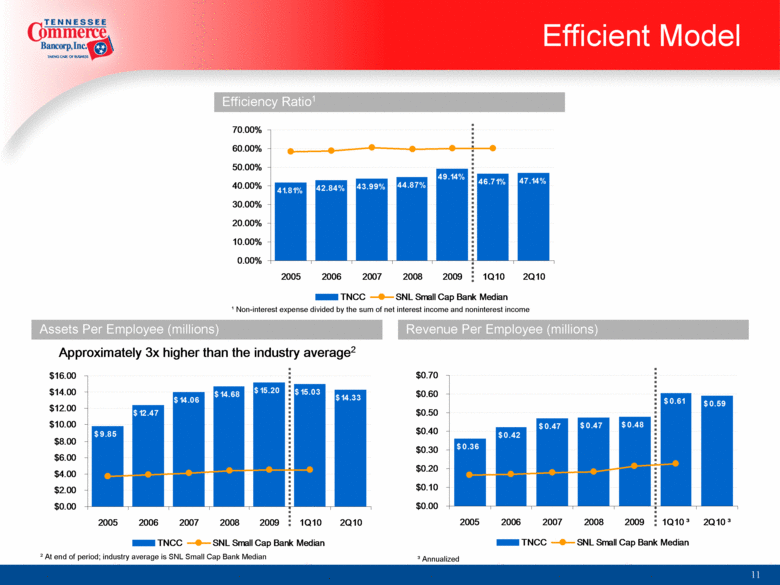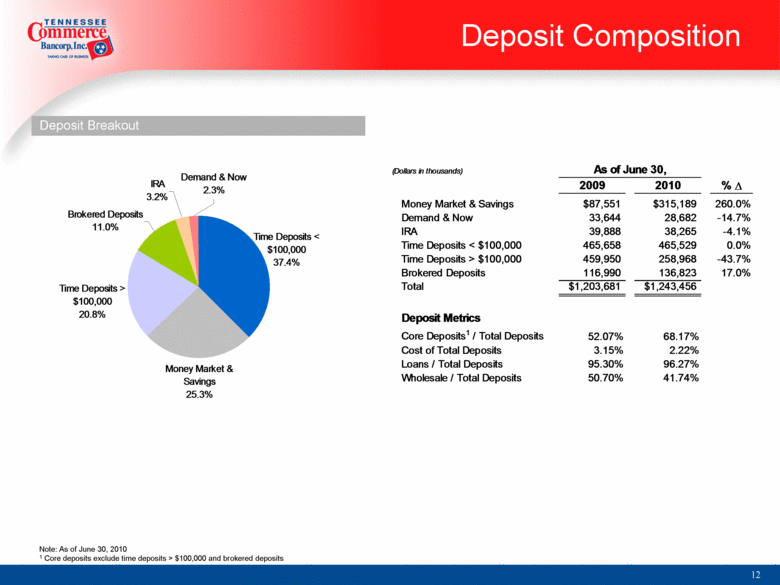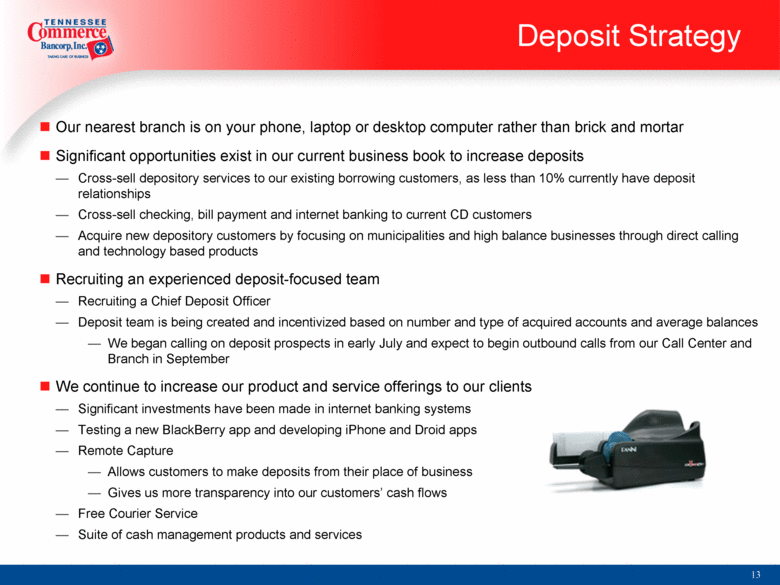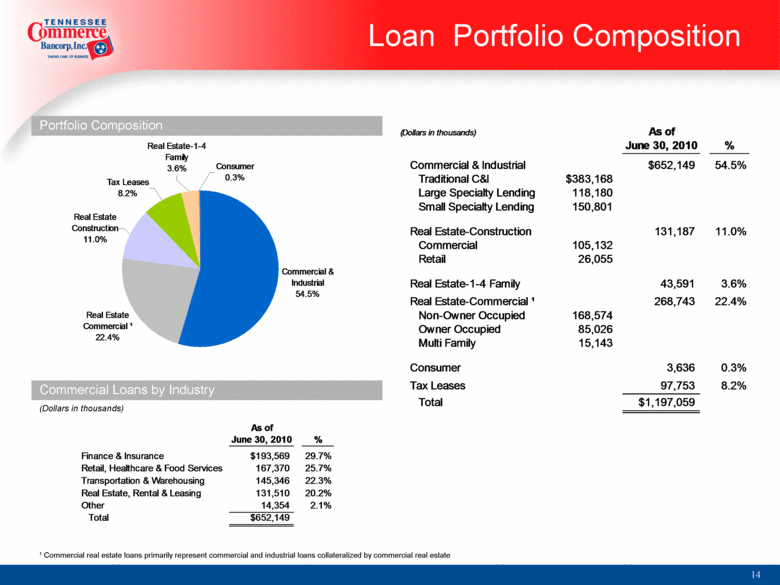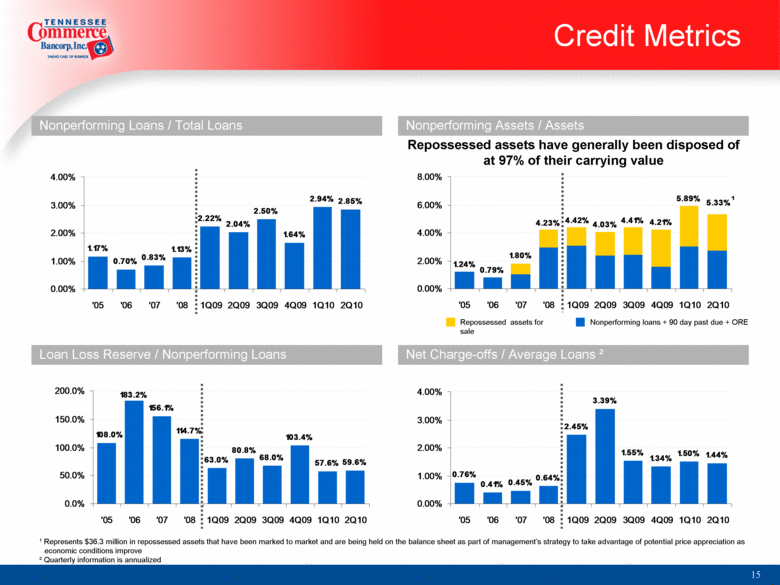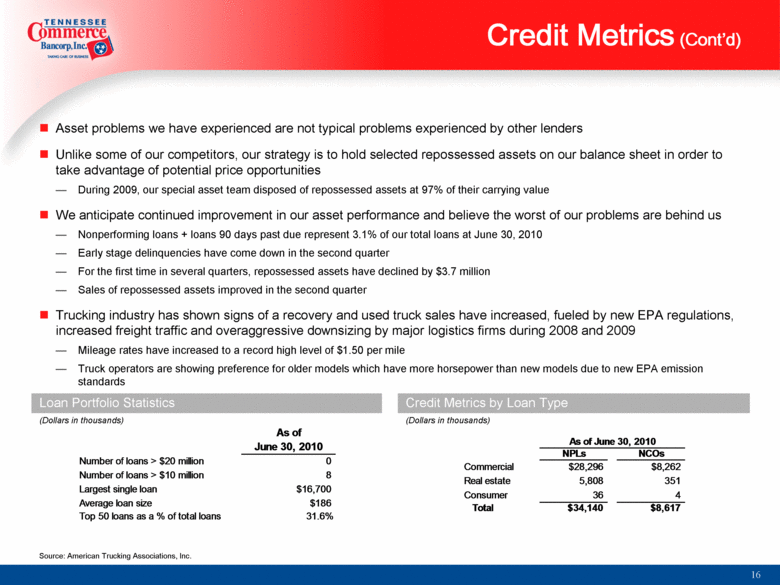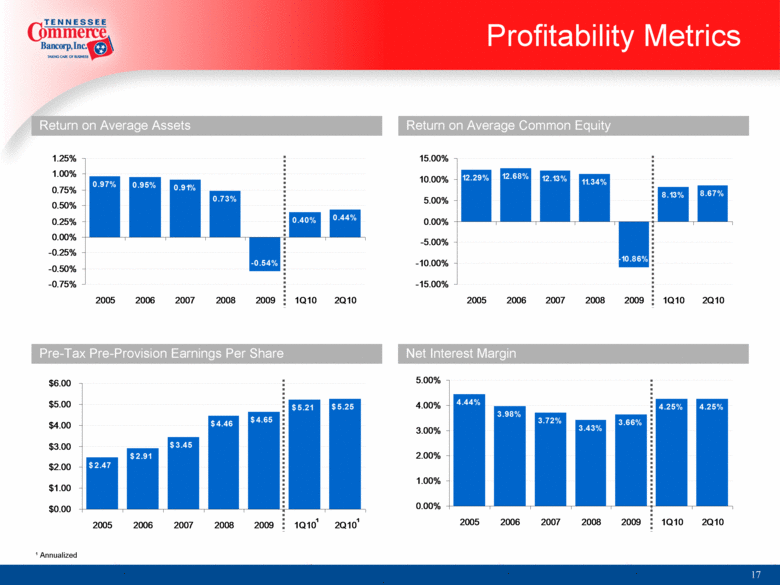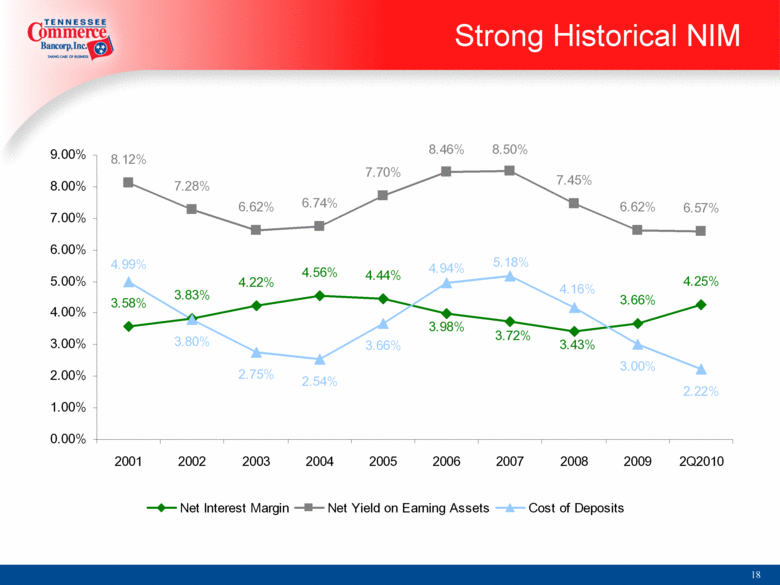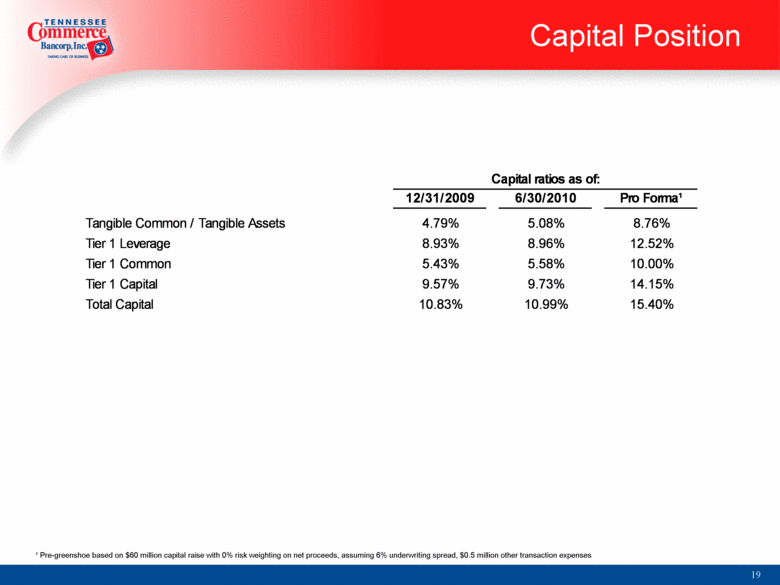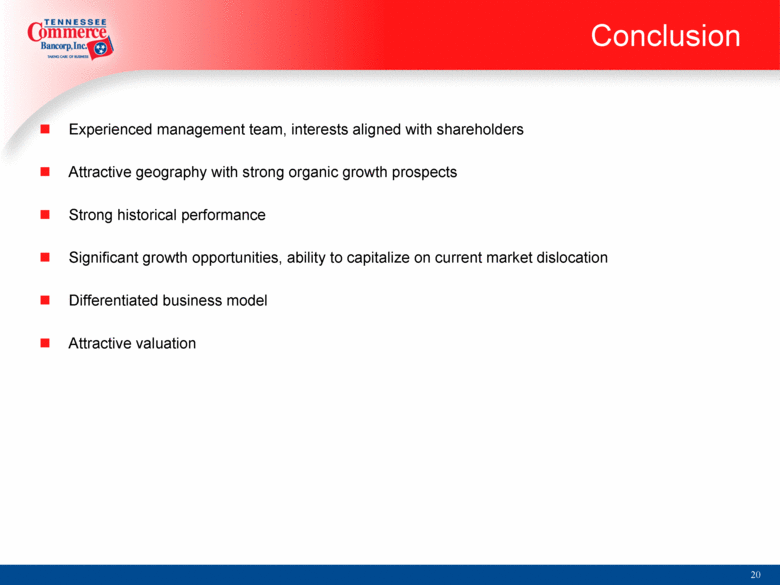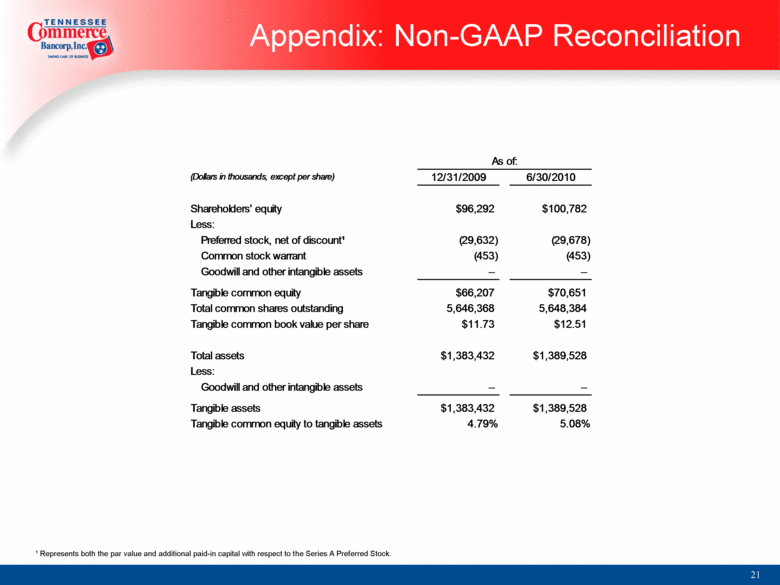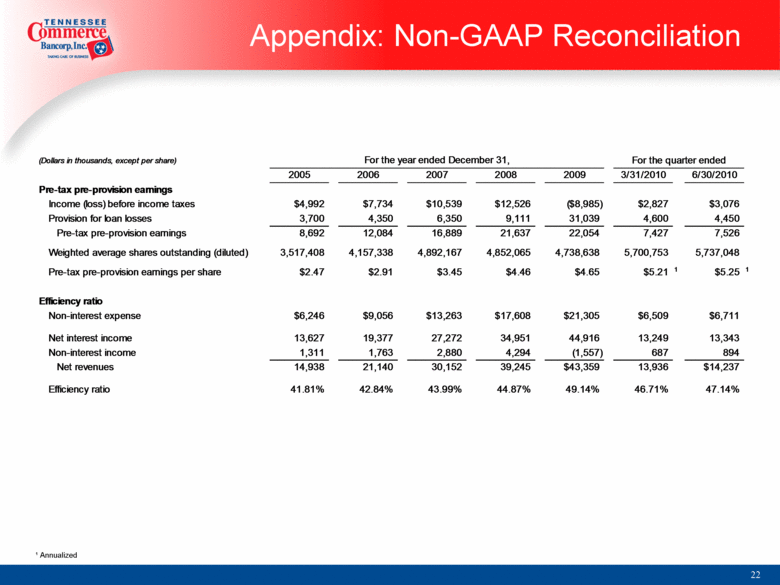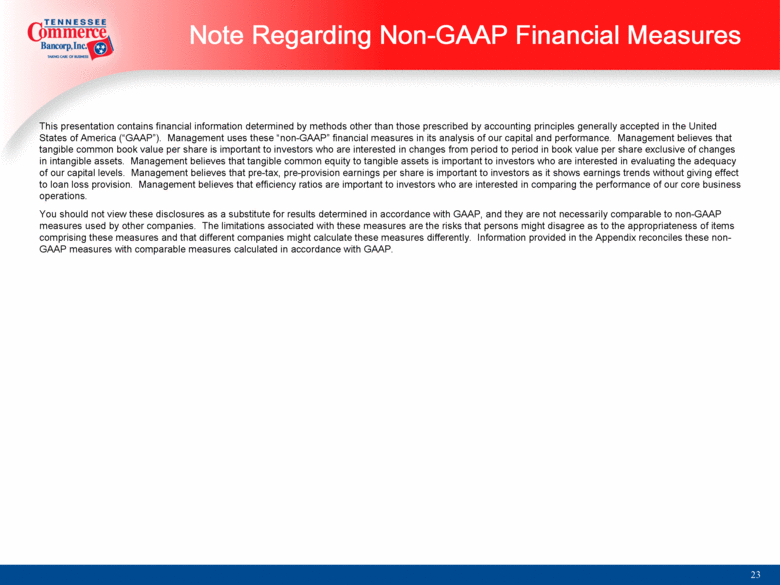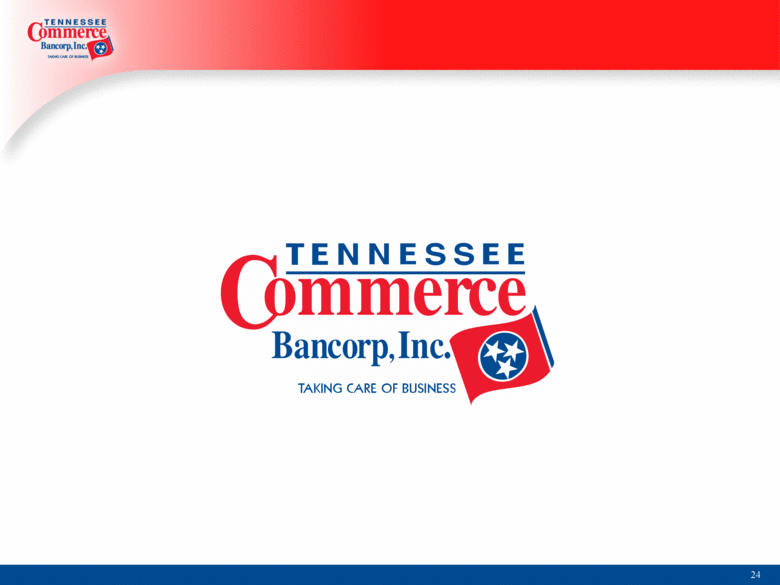Attached files
| file | filename |
|---|---|
| 8-K - 8-K - Tennessee Commerce Bancorp, Inc. | a10-10872_98k.htm |
| EX-99.1 - EX-99.1 - Tennessee Commerce Bancorp, Inc. | a10-10872_9ex99d1.htm |
Exhibit 99.2
|
|
TENNESSEE COMMERCE BANCORP, INC. Roadshow Presentation NASDAQ: TNCC www.tncommercebank.com July 2010 |
|
|
Cautionary Note Regarding Forward-Looking Statements This presentation contains forward-looking statements within the meaning of Section 27A of the Securities Act of 1933 and Section 21E of the Securities Exchange Act of 1934. Forward-looking statements, which are based on assumptions and estimates and describe our future plans, strategies, and expectations, are generally identifiable by the use of the words “anticipate,” “will,” “believe,” “may,” “could,” “would,” “should,” “estimate,” “expect,” “intend,” “seek,” or similar expressions. These forward-looking statements may address, among other things, our business plans, objectives or goals for future operations or expansion, including efforts to increase core deposits, our forecasted revenues, earnings, assets, or other measures of performance, including asset performance, or estimates of risks and future costs and benefits. Although these statements reflect our good faith belief based on current expectations, estimates and projections, they are subject to risks, uncertainties and assumptions, and are not guarantees of future performance. Important factors that could cause actual results to differ materially from the forward-looking statements we make in this presentation include, but are not limited to: the effects of future economic, business and market conditions and changes, domestic and foreign, that may affect general economic conditions; governmental monetary and fiscal policies; legislative and regulatory changes, including changes in banking, securities and tax laws, regulations and policies and their application by our regulators, and changes in the scope and cost of FDIC insurance and other coverage; negative developments in the financial services industry and U.S. and global credit markets; the effect of capital constraints on our pace of growth and our ability to raise additional capital when needed, and the Dodd-Frank Act, which changes the definition and amounts of minimum capital required of banking institutions; the risks of changes in interest rates on the levels, composition and costs of deposits, loan demand and the values and liquidity of loan collateral, securities and interest-sensitive assets and liabilities; fluctuations in non-interest income, including limitations on bank fees and charges contained in the Dodd-Frank Act; the financial health of the local economies in which we do business; our concentration of commercial and industrial loans; the sufficiency of our current sources of funds; our use of internet and brokered deposits; informal or formal enforcement actions to which we may become subject; our reliance on key personnel; changes in accounting policies, rules and practices; changes in borrower credit risks and payment behaviors; changes in the availability and cost of credit and capital in the financial markets; changes in the prices, values and sales volumes of real and personal property that we need to dispose of following foreclosure; the failure of assumptions and estimates underlying the establishment of reserves for possible loan losses and other estimates; certain risks related to mergers, acquisitions and divestitures, including, without limitation, the related time and costs of implementing such transactions, integrating operations as part of these transactions and possible failures to achieve expected gains, revenue growth and/or expense savings from such transactions; changes in technology or products that may be more difficult and costly or less effective than anticipated; the payment and liquidation rights of holders of our Fixed Rate Cumulative Perpetual Preferred Stock, Series A, and holders of our subordinated debentures; any future issuances of our common stock or other equity securities; reductions in our deferred tax assets; reductions in the amount of net operating loss carryforwards that we may be able to utilize for income tax purposes; and other factors and risks described in any of our reports filed with the Securities and Exchange Commission under the Securities Exchange Act of 1934. If one or more of these risks or uncertainties materialize, or if any of our underlying assumptions prove incorrect, our actual results, performance, or achievements may vary materially from future results, performance, or achievements expressed or implied by these forward-looking statements. All forward-looking statements attributable to us or persons acting on our behalf are expressly qualified in their entirety by the cautionary statements in this section. We do not intend to and assume no responsibility for updating or revising any forward-looking statements contained in this presentation, whether as a result of new information, future events, or otherwise. |
|
|
Offering Summary 1.3 million shares (approx. $9 million)1 Over-allotment: Week of August 2, 2010 Expected Pricing: Sterne Agee; FIG Partners, LLC; Odeon Capital Group Co-Managers: Macquarie Capital Bookrunner: Fund organic growth Enhance the Company's depository franchise, including possible FDIC-assisted transactions Acquire distressed assets from the FDIC if favorable terms are available Repay $8.75 million of parent level indebtedness General corporate purposes Use of Proceeds: 14.6 million shares1, 2 Total Shares Outstanding Post Offering: Approx. $37.8 million1; post offering: $97.8 million1, 2 Market Capitalization: 9.0 million shares (approx. $60 million)1, 2 Offering Size: $6.70 (as of July 27, 2010) Stock Price: TNCC / Nasdaq Global Market Ticker / Exchange: Tennessee Commerce Bancorp, Inc. Issuer: Offering Terms: 1 At July 27, 2010 share price 2 Excluding over-allotment |
|
|
Company Overview Tennessee Commerce is a $1.4 billion business bank located in Franklin, TN, within the Nashville MSA Core strategic focus on secured lending to small and mid-sized businesses Over 50% of our loan portfolio consists of C&I Focused on C&I lending for over a decade The vast majority of our loans are well secured by a variety of collateral Highly experienced management team Majority of the senior management team has 30+ years of commercial lending experience Lenders have on average 28 years of experience Growing steadily and profitably; opportunity to fill the gap left by distracted competitors Rationale for raising capital: Proactively address potentially higher capital levels mandated by regulators Build offensive capital to grow our franchise prudently, take market share from competitors Opportunity to build out deposit franchise to improve funding base Credit quality has been stable and improving; capital is not being raised out of concerns over potential credit losses in our loan portfolio |
|
|
Company Profile Business bank focused on secured lending to small and medium sized businesses, entrepreneurs and professionals in the Nashville MSA Headquartered in Franklin (Williamson County), TN 3 Loan Production Offices: Birmingham, AL Atlanta, GA Minneapolis, MN #1 Deposit market share in Williamson County One of the most affluent and rapidly growing counties in the country Assets: $1.4 billion Net Loans: $1.2 billion TBV / Share: $12.51 Market Cap (July 27, 2010): $37.8 million Price / Tangible Book Value: 0.54x 10 year CAGR of Assets: 49.0% Net Interest Margin (Q2 2010): 4.25% Efficiency Ratio (Q2 2010): 47.14% TCE / TA: 5.08% Tier 1 Common Ratio: 5.58% Total Risk Based Capital Ratio: 10.99% Key Financial Metrics (June 30, 2010) Source: ESRI and SNL Financial |
|
|
Investment Highlights Business bank focused on lending to small and medium sized enterprises (“SME”) Decade of C&I lending experience 49.0% CAGR in assets over last 10 years; not reliant on M&A for growth Experienced management team whose interests are aligned with shareholders Significant growth opportunities Opportunity to take market share from distracted competitors such as Regions, Bank of America, SunTrust, Pinnacle, Fifth Third, Wachovia and Synovus Lending teams already in place with the capacity to support additional growth Opportunity to lift out additional lending teams from weakened competitors Experienced team currently in place to evaluate distressed asset purchases Opportunity to increase deposits through cross-selling and expansion of deposit team Attractive market demographics Local economy has experienced rapid growth from diverse industries including health services, education, automotive, publishing, insurance and technology Williamson County has 17th highest median income in the U.S. High concentration of entrepreneurs in local business community, one of the top 10 cities for start-ups Differentiated business model Long-term relationships and a firm understanding of our clients’ businesses and cash flows Ability to evaluate opportunities and respond quickly to lending opportunities Expertise in areas of specialty finance in addition to conventional commercial lending Strong emphasis on customer service results in above average returns Source: ESRI and SNL Financial |
|
|
Average years experience: Average years of experience per lender: 31 28 Management Team 35 35 30 41 12 32 32 Years in Industry 7 5 4 10 2 1 10 Years at TNCC Various positions at NationsBank of Tennessee, C&S Bank, Hibernia Bank and Commerce Union Chief Operating Officer H. Lamar Cox Name Position Background Michael R. Sapp Chairman, Chief Executive Officer and President Senior Vice President – First American National Lending Officer – BancOhio National Bank Martin M. Zorn Chief Administrative Officer COO, CFO, & Secretary – Integra Bank Regional Vice President and Region Executive (Washington D.C.) – Wachovia Frank Perez Chief Financial Officer CFO – Cumberland Bank & Trust, Audit Manager – Crowell & Crowell, PLLC Senior Accountant – AIG American General Senior Accountant – Crowe Chizek Tommy Crocker Chief Risk Officer Senior Vice President – First American National President & COO – First American Commercial Finance Doug Rogers National Lending Executive Commercial Lender – Commerce Union Bank Commercial Lender – First American National John Burton Regional Lending Executive Senior Vice President – Commerce Union CFO – Advanced Integrated Technologies |
|
|
Q2 Results Summary Net income, before preferred dividend, of $1.9 million; $0.26 per diluted share (after preferred dividend) Represents ROAA of 0.44% and ROACE of 8.67% Net interest income of $13.3 million representing an improvement of 27.7% compared to Q2 2009 Net interest margin of 4.25% Efficiency ratio of 47.14% Credit trends: Adjusted NPAs1 decreased $7.4 million from the first quarter to 5.33% of total assets (includes a $3.7 million reduction in repossessed assets) NPLs + loans 90 days past due decreased $4 million from the first quarter to 3.1% of total loans LLP decreased $150,000 from the first quarter to $4.5 million Reserves increased from the first quarter to $20.3 million, representing 1.70% of total loans Significant improvement in early stage delinquencies (30-89 day) from 4.5% to 2.2% of total loans for the first quarter and second quarter, respectively 1 Adjusted non-performing assets are comprised of nonaccrual loans, troubled debt, loans 90+ days past due, repossessions and other real estate owned |
|
|
Our Market We operate in the Nashville Metropolitan market, more specifically Williamson and Davidson counties, from our headquarters in Franklin Williamson County is one of the most affluent and rapidly growing counties in the nation with 48% of households earning above $100,000 per year in 2009 Population has grown approximately 40% since 2000 Franklin is the headquarters for a variety of automotive, technology, insurance, publishing and health services companies Favorable tax and pro-business political climate has been a major factor in companies relocating to Tennessee and Williamson county Regional demographics of the I-65 corridor: Nashville is a top region for industry expansion and not reliant on any single sector for growth The Huntsville, AL area is experiencing meaningful growth due to new technology firms establishing a presence in the area Birmingham, AL is one of the top 10 Southeastern technology centers and offers meaningful growth opportunities as a result of national banking consolidations Chattanooga was ranked 8th by Forbes out of the top 100 largest metro areas for the best “Bang for your Buck”. It’s economy is driven by a growing mix of manufacturing and service industries Six Interstate Legs Meet in Nashville Source: ESRI and SNL Financial |
|
|
C&I Focus Secured lender with over 96% of our portfolio secured by physical assets / personal guarantees, resulting in low historical loss levels (average of 89 basis points per year for the past 5 years) No shared national credits and no sub-prime or alt-A loans Small but highly liquid and conservative investment portfolio Direct / owner managed business lending in markets we know well Credit enhanced lending including USDA credit enhancement under its Rural Development Program loans Growing and profitable specialty lender High quality loans; mission critical equipment with above average returns and prospective future growth Opportunity to grow in this market as traditional lenders such as CIT and GE pull back Finance transactions for NYSE, Bank of America, SunTrust, Zions Bancorp and U-Haul Expertise in additional specialty finance areas including tax leases and asset-based lending High customer attraction and retention rate due to service-oriented business model Scalable business platform and efficient operating model Recently made large investments in technology and infrastructure |
|
|
Efficient Model Efficiency Ratio1 Approximately 3x higher than the industry average2 Assets Per Employee (millions) Revenue Per Employee (millions) ³ Annualized ² At end of period; industry average is SNL Small Cap Bank Median ¹ Non-interest expense divided by the sum of net interest income and noninterest income $0.36 $0.42 $0.47 $0.47 $0.48 $0.61 $0.59 $0.00 $0.10 $0.20 $0.30 $0.40 $0.50 $0.60 $0.70 2005 2006 2007 2008 2009 1Q10 ³ 2Q10 ³ TNCC SNL Small Cap Bank Median $9.85 $12.47 $14.06 $14.68 $15.20 $15.03 $14.33 $0.00 $2.00 $4.00 $6.00 $8.00 $10.00 $12.00 $14.00 $16.00 2005 2006 2007 2008 2009 1Q10 2Q10 TNCC SNL Small Cap Bank Median 70.00% 60.00% 50.00% 40.00% 30.00% 20.00% 10.00% 0.00% |
|
|
Deposit Composition Note: As of June 30, 2010 1 Core deposits exclude time deposits > $100,000 and brokered deposits Deposit Breakout Money Market & Savings 25.3% Time Deposits < $100,000 37.4% Demand & Now 2.3% Brokered Deposits 11.0% IRA 3.2% Time Deposits > $100,000 20.8% (Dollars in thousands) As of June 30, 2009 2010 % r Money Market & Savings $87,551 $315,189 260.0% Demand & Now 33,644 28,682 -14.7% IRA 39,888 38,265 -4.1% Time Deposits < $100,000 465,658 465,529 0.0% Time Deposits > $100,000 459,950 258,968 -43.7% Brokered Deposits 116,990 136,823 17.0% Total $1,203,681 $1,243,456 Deposit Metrics Core Deposits1 / Total Deposits 52.07% 68.17% Cost of Total Deposits 3.15% 2.22% Loans / Total Deposits 95.30% 96.27% Wholesale / Total Deposits 50.70% 41.74% |
|
|
Deposit Strategy Our nearest branch is on your phone, laptop or desktop computer rather than brick and mortar Significant opportunities exist in our current business book to increase deposits Cross-sell depository services to our existing borrowing customers, as less than 10% currently have deposit relationships Cross-sell checking, bill payment and internet banking to current CD customers Acquire new depository customers by focusing on municipalities and high balance businesses through direct calling and technology based products Recruiting an experienced deposit-focused team Recruiting a Chief Deposit Officer Deposit team is being created and incentivized based on number and type of acquired accounts and average balances We began calling on deposit prospects in early July and expect to begin outbound calls from our Call Center and Branch in September We continue to increase our product and service offerings to our clients Significant investments have been made in internet banking systems Testing a new BlackBerry app and developing iPhone and Droid apps Remote Capture Allows customers to make deposits from their place of business Gives us more transparency into our customers’ cash flows Free Courier Service Suite of cash management products and services |
|
|
Loan Portfolio Composition ¹ Commercial real estate loans primarily represent commercial and industrial loans collateralized by commercial real estate Portfolio Composition Commercial Loans by Industry (Dollars in thousands) (Dollars in thousands) As of June 30, 2010 % Commercial & Industrial $652,149 54.5% Traditional C&I $383,168 Large Specialty Lending 118,180 Small Specialty Lending 150,801 Real Estate-Construction 131,187 11.0% Commercial 105,132 Retail 26,055 Real Estate-1-4 Family 43,591 3.6% Real Estate - Commercial ¹ 268,743 22.4% Non-Owner Occupied 168,574 Owner Occupied 85,026 Multi Family 15,143 Consumer 3,636 0.3% Tax Leases 97,753 8.2% Total $1,197,059 As of June 30, 2010 % Finance & Insurance $193,569 29.7% Retail, Healthcare & Food Services 167,370 25.7% Transportation & Warehousing 145,346 22.3% Real Estate, Rental & Leasing 131,510 20.2% Other 14,354 2.1% Total $652,149 |
|
|
Credit Metrics Loan Loss Reserve / Nonperforming Loans Net Charge-offs / Average Loans ² Nonperforming Assets / Assets ¹ Repossessed assets for sale Nonperforming loans + 90 day past due + ORE ¹ Represents $36.3 million in repossessed assets that have been marked to market and are being held on the balance sheet as part of management’s strategy to take advantage of potential price appreciation as economic conditions improve ² Quarterly information is annualized Repossessed assets have generally been disposed of at 97% of their carrying value Nonperforming Loans / Total Loans 156.1% 114.7% 63.0% 80.8% 68.0% 103.4% 57.6% 59.6% 183.2% 108.0% 0.0% 50.0% 100.0% 150.0% 200.0% '05 '06 '07 '08 1Q09 2Q09 3Q09 4Q09 1Q10 2Q10 0.76% 0.41% 0.45% 0.64% 2.45% 3.39% 1.55% 1.34% 1.50% 1.44% 0.00% 1.00% 2.00% 3.00% 4.00% '05 '06 '07 '08 1Q09 2Q09 3Q09 4Q09 1Q10 2Q10 5.33% 5.89% 4.21% 4.41% 4.03% 4.42% 4.23% 1.80% 0.79% 1.24% 0.00% 2.00% 4.00% 6.00% 8.00% '05 '06 '07 '08 1Q09 2Q09 3Q09 4Q09 1Q10 2Q10 1.17% 0.70% 0.83% 1.13% 2.22% 2.04% 2.50% 1.64% 2.94% 2.85% 0.00% 1.00% 2.00% 3.00% 4.00% '05 '06 '07 '08 1Q09 2Q09 3Q09 4Q09 1Q10 2Q10 |
|
|
Credit Metrics (Cont’d) Asset problems we have experienced are not typical problems experienced by other lenders Unlike some of our competitors, our strategy is to hold selected repossessed assets on our balance sheet in order to take advantage of potential price opportunities During 2009, our special asset team disposed of repossessed assets at 97% of their carrying value We anticipate continued improvement in our asset performance and believe the worst of our problems are behind us Nonperforming loans + loans 90 days past due represent 3.1% of our total loans at June 30, 2010 Early stage delinquencies have come down in the second quarter For the first time in several quarters, repossessed assets have declined by $3.7 million Sales of repossessed assets improved in the second quarter Trucking industry has shown signs of a recovery and used truck sales have increased, fueled by new EPA regulations, increased freight traffic and overaggressive downsizing by major logistics firms during 2008 and 2009 Mileage rates have increased to a record high level of $1.50 per mile Truck operators are showing preference for older models which have more horsepower than new models due to new EPA emission standards Credit Metrics by Loan Type Loan Portfolio Statistics (Dollars in thousands) Source: American Trucking Associations, Inc. (Dollars in thousands) As of June 30, 2010 NPLs NCOs Commercial $28,296 $8,262 Real estate 5,808 351 Consumer 36 4 Total $34,140 $8,617 As of June 30, 2010 Number of loans > $20 million 0 Number of loans > $10 million 8 Largest single loan $16,700 Average loan size $186 Top 50 loans as a % of total loans 31.6% |
|
|
Profitability Metrics Return on Average Assets Return on Average Common Equity Pre-Tax Pre-Provision Earnings Per Share Net Interest Margin ¹ ¹ ¹ Annualized 12.29% 12.68% 12.13% 11.34% -10.86% 8.13% 8.67% -15.00% -10.00% -5.00% 0.00% 5.00% 10.00% 15.00% 2005 2006 2007 2008 2009 1Q10 2Q10 4.44% 3.98% 3.72% 3.43% 3.66% 4.25% 4.25% 0.00% 1.00% 2.00% 3.00% 4.00% 5.00% 2005 2006 2007 2008 2009 1Q10 2Q10 $2.47 $2.91 $3.45 $4.46 $4.65 $5.21 $5.25 $0.00 $1.00 $2.00 $3.00 $4.00 $5.00 $6.00 2005 2006 2007 2008 2009 1Q10 2Q10 0.97% 0.95% 0.91% 0.73% -0.54% 0.40% 0.44% -0.75% -0.50% -0.25% 0.00% 0.25% 0.50% 0.75% 1.00% 1.25% 2005 2006 2007 2008 2009 1Q10 2Q10 |
|
|
Strong Historical NIM 3.58% 3.83% 4.22% 4.56% 4.44% 3.66% 4.25% 8.12% 7.28% 6.62% 6.74% 7.70% 8.46% 8.50% 7.45% 6.62% 6.57% 3.43% 3.72% 3.98% 4.99% 4.94% 3.80% 2.75% 2.54% 3.66% 5.18% 4.16% 2.22% 3.00% 0.00% 1.00% 2.00% 3.00% 4.00% 5.00% 6.00% 7.00% 8.00% 9.00% 2001 2002 2003 2004 2005 2006 2007 2008 2009 2Q2010 Net Interest Margin Net Yield on Earning Assets Cost of Deposits |
|
|
Capital Position 1 Pre-greenshoe based on $60 million capital raise with 0% risk weighting on net proceeds, assuming 6% underwriting spread, $0.5 million other transaction expenses Capital ratios as of: 12/31/2009 6/30/2010 Pro Forma 1 Tangible Common / Tangible Assets 4.79% 5.08% 8.76% Tier 1 Leverage 8.93% 8.96% 12.52% Tier 1 Common 5.43% 5.58% 10.00% Tier 1 Capital 9.57% 9.73% 14.15% Total Capital 10.83% 10.99% 15.40% |
|
|
Experienced management team, interests aligned with shareholders Attractive geography with strong organic growth prospects Strong historical performance Significant growth opportunities, ability to capitalize on current market dislocation Differentiated business model Attractive valuation Conclusion |
|
|
Appendix: Non-GAAP Reconciliation ¹ Represents both the par value and additional paid-in capital with respect to the Series A Preferred Stock. As of: 12/31/2009 6/30/2010 Shareholders' equity $96,292 $100,782 Less: Preferred stock , net of discount¹ (29,632) (29,678) Common stock warrant (453) (453) Goodwill and other intangible assets – – Tangible common equity $66,207 $70,651 Total common shares outstanding 5,646,368 5,648,384 Tangible common book value per share $11.73 $12.51 Total assets $1,383,432 $1,389,528 Less: Goodwill and other intangible assets – – Tangible assets $1,383,432 $1,389,528 Tangible common equity to tangible assets 4.79% 5.08% (Dollars in thousands, except per share) |
|
|
Appendix: Non-GAAP Reconciliation ¹ Annualized (Dollars in thousands, except per share) For the year ended December 31, For the quarter ended 2005 2006 2007 2008 2009 3/31/2010 6/30/2010 Income (loss) before income taxes $4,992 $7,734 $10,539 $12,526 ($8,985) $2,827 $3,076 Provision for loan losses 3,700 4,350 6,350 9,111 31,039 4,600 4,450 Pre-tax pre-provision earnings 8,692 12,084 16,889 21,637 22,054 7,427 7,526 Weighted average shares outstanding (diluted) 3,517,408 4,157,338 4,892,167 4,852,065 4,738,638 5,700,753 5,737,048 Pre-tax pre-provision earnings per share $2.47 $2.91 $3.45 $4.46 $4.65 $5.21 1 $5.25 1 Non-interest expense $6,246 $9,056 $13,263 $17,608 $21,305 $6,509 $6,711 Net interest income 13,627 19,377 27,272 34,951 44,916 13,249 13,343 Non-interest income 1,311 1,763 2,880 4,294 (1,557) 687 894 Net revenues 14,938 21,140 30,152 39,245 $43,359 13,936 $14,237 Efficiency ratio 41.81% 42.84% 43.99% 44.87% 49.14% 46.71% 47.14% Pre-tax pre-provision earnings Efficiency ratio |
|
|
Note Regarding Non-GAAP Financial Measures This presentation contains financial information determined by methods other than those prescribed by accounting principles generally accepted in the United States of America (“GAAP”). Management uses these “non-GAAP” financial measures in its analysis of our capital and performance. Management believes that tangible common book value per share is important to investors who are interested in changes from period to period in book value per share exclusive of changes in intangible assets. Management believes that tangible common equity to tangible assets is important to investors who are interested in evaluating the adequacy of our capital levels. Management believes that pre-tax, pre-provision earnings per share is important to investors as it shows earnings trends without giving effect to loan loss provision. Management believes that efficiency ratios are important to investors who are interested in comparing the performance of our core business operations. You should not view these disclosures as a substitute for results determined in accordance with GAAP, and they are not necessarily comparable to non-GAAP measures used by other companies. The limitations associated with these measures are the risks that persons might disagree as to the appropriateness of items comprising these measures and that different companies might calculate these measures differently. Information provided in the Appendix reconciles these non-GAAP measures with comparable measures calculated in accordance with GAAP. |
|
|
[LOGO] |

